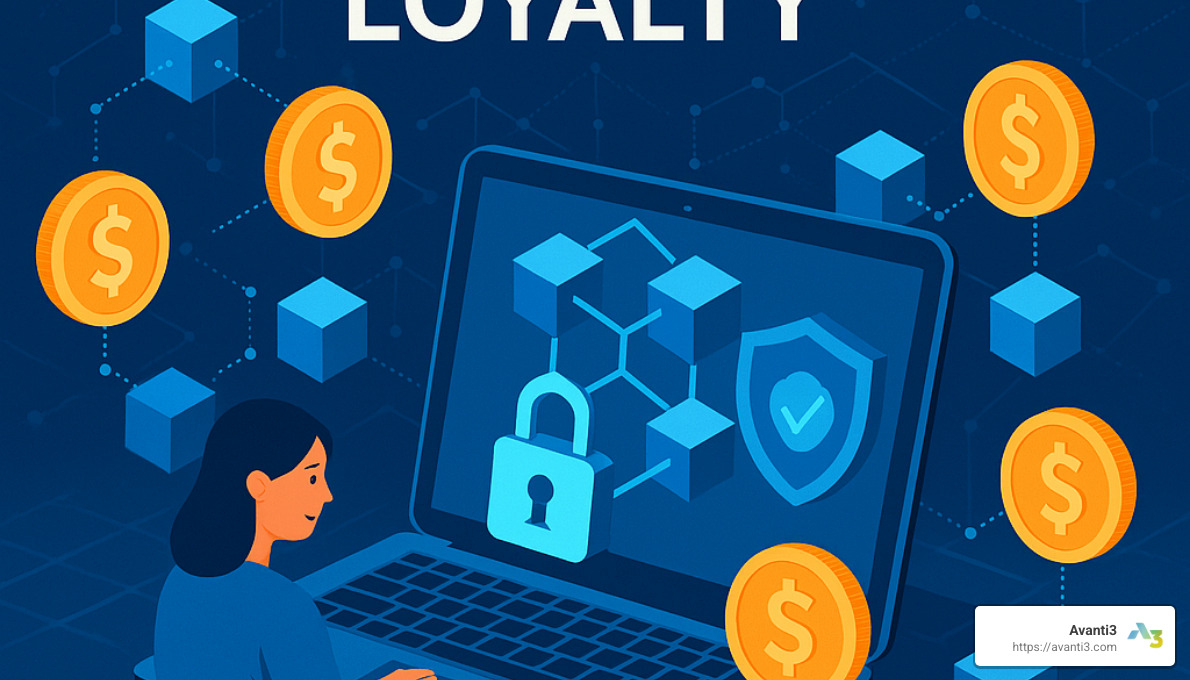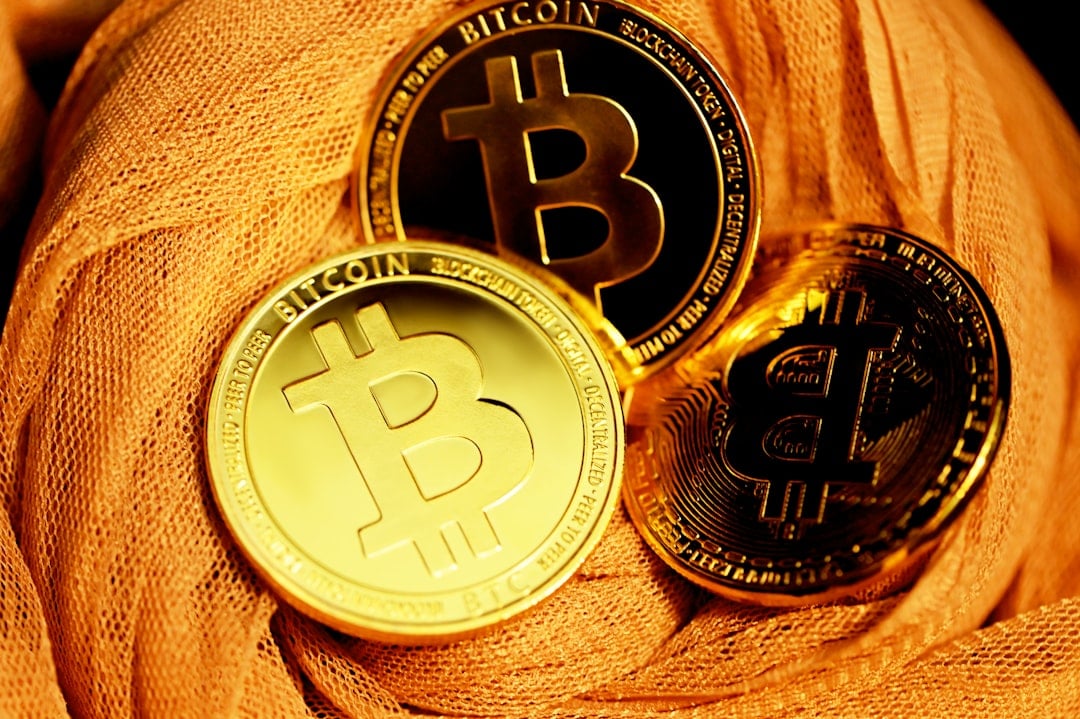Why Blockchain-based rewards are revolutionizing customer loyalty
Blockchain-based rewards are loyalty incentives managed through blockchain technology, enabling transparent, secure, and flexible reward systems.
In simple terms, blockchain-based rewards allow brands to:
- Issue secure, fraud-resistant rewards using blockchain’s cryptographic security.
- Enable fast, transparent reward tracking with real-time transactions recorded on an immutable ledger.
- Offer flexible, interoperable rewards, allowing users to easily redeem across brands or convert rewards into valuable digital assets (like NFTs or tokens).
Traditional loyalty programs often frustrate customers with confusing rules, slow reward crediting, and limited flexibility. As Rahul Jaiswal, Principal Research Director, Retail, notes:
“A Web3 blockchain-based NFT loyalty program increases the extent of partnerships, collaboration, and visibility for establishing a unique open loyalty ecosystem.”
We’ll explore exactly how blockchain-based rewards address these traditional pain points and how your brand can leverage this innovative technology.
My name is Samir ElKamouny AV, and as an entrepreneur and marketing expert, I’ve personally assisted numerous businesses in adopting Blockchain-based rewards to achieve deeper customer engagement and open up new revenue opportunities. Below, we’ll dive into exactly how it all works.
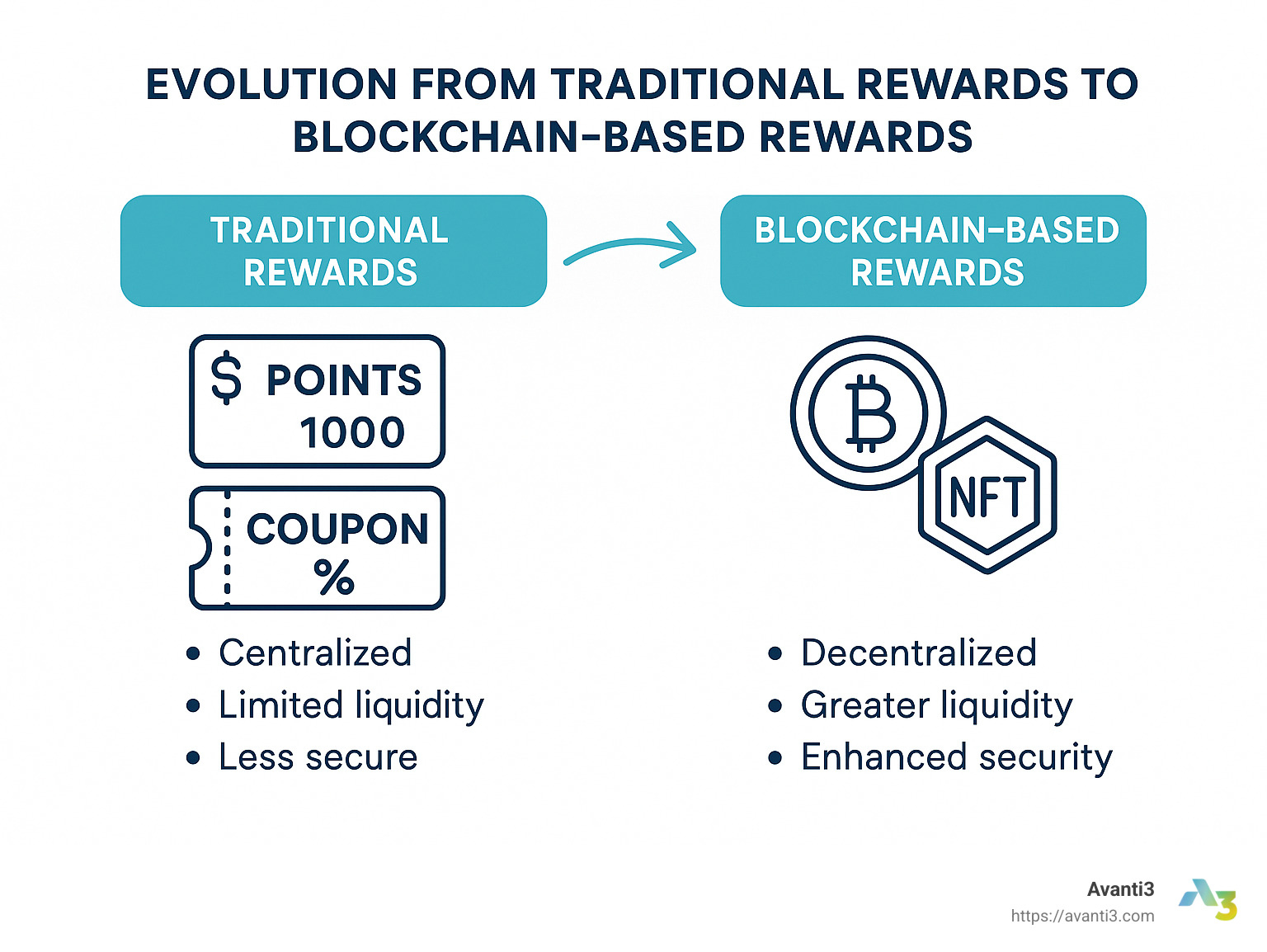
Understanding Blockchain-Based Rewards
Let’s take a closer look at exactly what blockchain-based rewards are—and why they’re shaking things up compared to traditional loyalty programs.
At their heart, blockchain-based rewards use blockchain technology—basically a secure, digital ledger—to create, distribute, and manage customer loyalty incentives. Think of it as upgrading loyalty points from an old-school spreadsheet to an advanced, secure, and live-updated network. Instead of being stored privately by individual businesses, these rewards exist openly on a decentralized blockchain network. This ensures greater transparency, stronger security, and more options for customers to redeem their rewards.
The magic behind these new loyalty programs lies in something called tokenization. Tokenization simply means turning traditional rewards (like points or discounts) into digital tokens that live securely on the blockchain. These tokens come in two main flavors:
- Fungible tokens—these are like cryptocurrencies. Each token has the same value and can be easily transferred or traded between users.
- Non-fungible tokens (NFTs)—these are unique digital assets. Imagine collectible digital badges, exclusive event access, or even personalized digital artwork as rewards.
This might sound futuristic, but the shift is already happening in a big way. According to recent statistics, the loyalty management market was valued around $5.57 billion in 2022—and is expected to skyrocket to more than $24 billion by 2029, growing at a stunning rate of 23.5% per year. Blockchain innovation is a major driving force behind this growth.
Interestingly, although 74% of Americans belong to at least one loyalty program, they’re actively participating in less than half of the programs they’ve joined. Clearly, traditional reward systems aren’t keeping customers hooked. Blockchain-based rewards step in by offering more engaging, flexible, and user-friendly experiences that inspire customers to stick around.
The Mechanics of Blockchain in Loyalty Programs
Now let’s peek under the hood to see how blockchain-based rewards actually work.
The first key ingredient is something called smart contracts—little pieces of code that automatically handle transactions based on specific conditions. Think of smart contracts as loyalty “robots”—when a customer makes a purchase or meets another condition (like referring a friend or engaging on social media), the smart contract instantly and automatically issues rewards to their digital wallet. No waiting, no manual entries, and no headaches for businesses. Everything runs seamlessly, saving time and resources.
Next comes decentralization, which simply means that no single party controls the entire rewards system. Instead, blockchain-based programs run across many computers (or nodes), creating a collaborative network. This prevents any single business from manipulating the system, creating fairness and trust for everyone involved.
Transparency is another huge advantage here. Since all transactions are recorded publicly on an open ledger, customers can easily verify when they earned rewards and how many they have. Businesses can also clearly track program performance. Everyone stays on the same page—literally!
Finally, immutable ledgers ensure that once transactions are recorded on the blockchain, they’re permanent and impossible to alter. This creates a secure, tamper-proof history of every reward earned, redeemed, or transferred. No more disputes over missing points or incorrect balances—it’s all reliably recorded.
Imagine shopping at your favorite store and instantly seeing rewards appear in your digital wallet before you’ve even walked out the door—definitely a welcome change from waiting weeks for points. Customers get rewarded in near real-time, boosting satisfaction and encouraging engagement.
Together, these technologies—smart contracts, decentralization, transparency, and immutable records—make blockchain-based rewards more efficient, secure, and customer-friendly than traditional programs.
Curious about other creative ways to use blockchain? Check out Blockchain Content Distribution for more exciting possibilities.
Benefits of Blockchain-Based Rewards for Businesses
Implementing blockchain-based rewards isn’t just about keeping up with tech trends—it’s about creating real, tangible benefits for businesses and their customers. If you’re tired of loyalty programs that lack engagement, flexibility, or security, blockchain could be the breath of fresh air you’ve been looking for.
Let’s face it—traditional loyalty programs can feel outdated. Customers juggle dozens of cards and forget about points they’ve earned. Businesses, meanwhile, spend a fortune managing complex systems and dealing with fraud. Blockchain addresses these pain points directly, creating a smoother, safer, and more profitable experience for everyone involved.
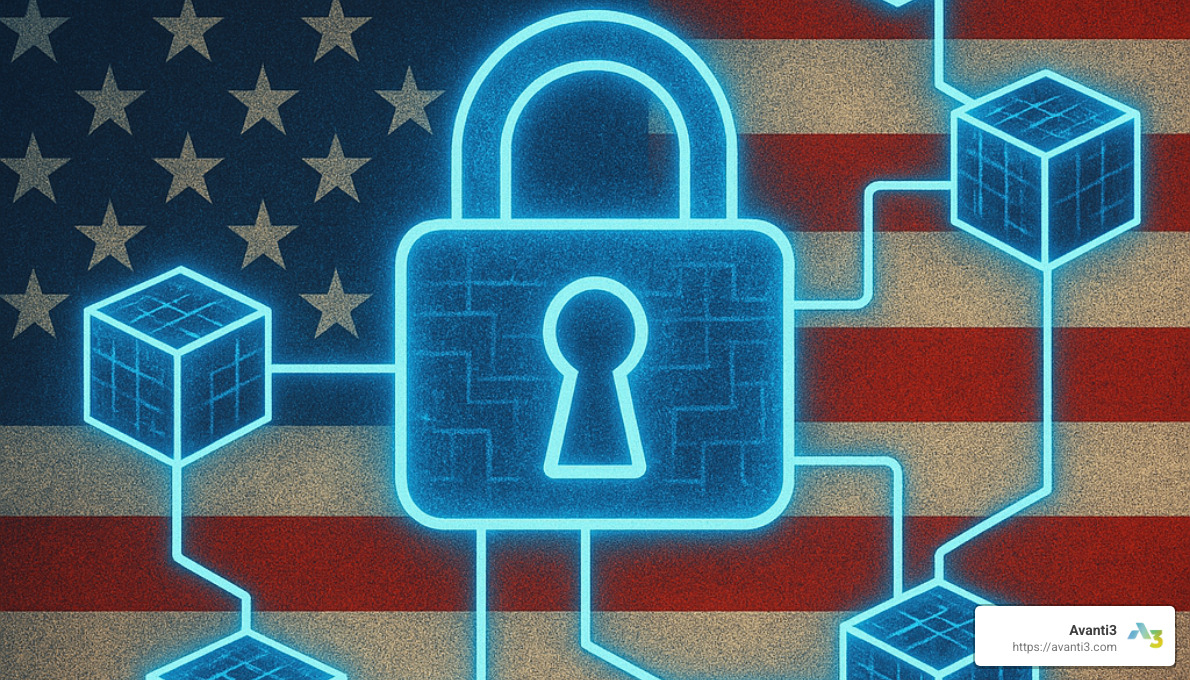
“Blockchain reduces the need for intermediaries, leading to significant cost efficiency in loyalty programs.”
One of the standout advantages of blockchain-based rewards is the ability to build truly open and interconnected loyalty ecosystems. Picture this: instead of your rewards program operating in isolation, blockchain technology lets you seamlessly integrate with partners, platforms, and channels. This openness means customers can redeem rewards across multiple brands, significantly boosting engagement and overall satisfaction.
Did you know the average U.S. shopper belongs to 16+ different loyalty programs but actively participates in fewer than seven? The truth is, many traditional programs are complicated and fragmented, causing customers to lose interest. Blockchain-based solutions simplify these systems, giving customers more reasons to stay active and engaged. Let’s dive deeper into some specific benefits.
Improved Security and Fraud Prevention with Blockchain-Based Rewards
Fraud and security issues can be a huge headache, with studies indicating that as many as 70% of traditional loyalty programs have experienced fraud. Thankfully, blockchain technology offers a far more secure approach.
Here’s how blockchain protects your loyalty program: it uses cryptographic security, which basically means each transaction is encrypted and practically impossible to tamper with. Since blockchain transactions are recorded on an open, transparent ledger, any suspicious activity becomes immediately apparent, reducing fraud dramatically.
Moreover, because blockchain creates immutable records (meaning they can’t be modified or deleted), there’s no chance of points being duplicated, stolen, or compromised. This isn’t just good news for your security team—it also builds trust among customers, showing them you’re serious about protecting their rewards and personal data.
Operational Efficiency and Cost Savings
Running traditional loyalty programs can be surprisingly expensive. Businesses reportedly spend around $35 billion each year just on third-party processors and intermediaries. Blockchain technology helps cut down these costs—and who doesn’t love saving money?
Blockchain-based loyalty programs help lower expenses by reducing intermediaries. Instead of relying on costly third-party administrators, businesses can interact directly with customers through decentralized platforms. This streamlines operations, eliminates unnecessary fees, and speeds things up.
Another major cost-saver is the use of smart contracts to automate processes. These clever, self-executing agreements handle reward distribution, redemption, and transfers automatically, saving your team hours of manual work. Faster transactions mean happier customers and fewer administrative headaches.
Still not convinced? One company that adopted blockchain-based rewards reported a 30% reduction in administrative costs and a 25% increase in customer engagement within the first year. That’s like having your cake and eating it too—lower costs and higher engagement, all at once!
To learn more about the efficiency gains blockchain can offer your loyalty programs, check out this scientific research on blockchain efficiencies.
In short, adopting blockchain-based rewards positions your brand as forward-thinking, customer-focused, and smart about resources. Blockchain isn’t just hype—it’s a practical solution to common loyalty program headaches, offering real benefits your business can feel.
Improving Customer Experience with Tokenized Rewards
While the business perks of blockchain-based rewards are impressive, the real magic happens at the customer level. Let’s be honest, traditional rewards programs can sometimes feel confusing and limiting—leaving customers frustrated rather than feeling rewarded. Blockchain technology and tokenization breathe new life into these programs, turning them into exciting experiences your customers will genuinely love to engage with.
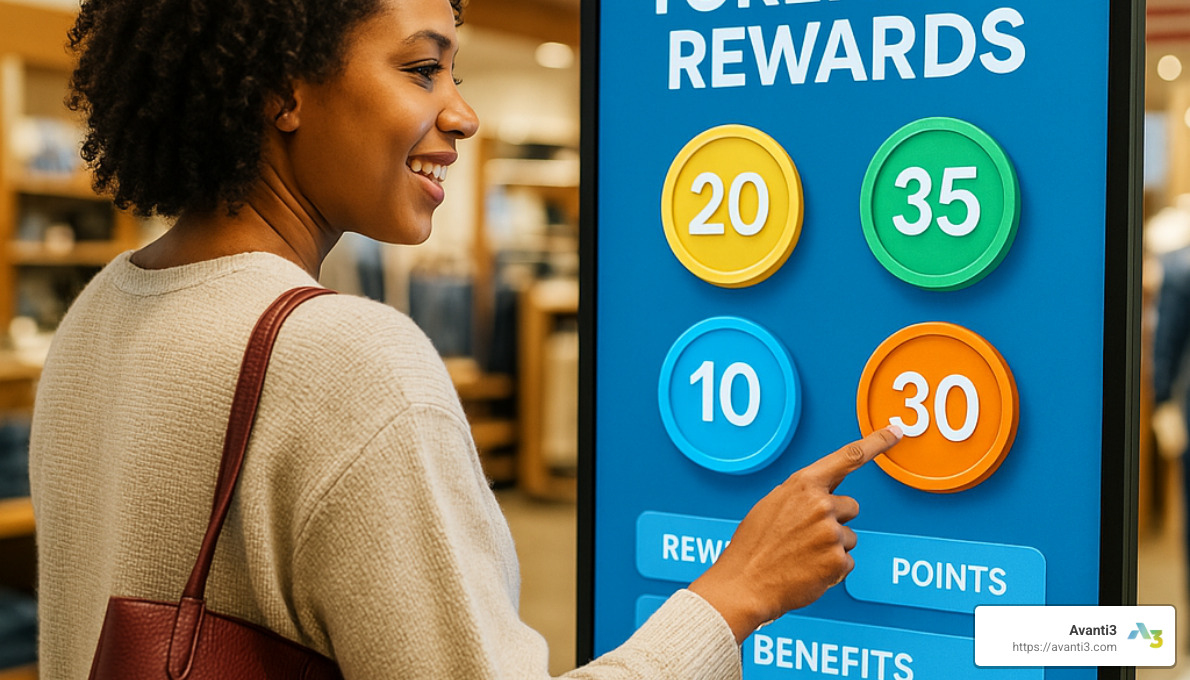
Here’s a fun fact: about 66% of consumers admit they adjust their spending just to earn maximum rewards. Even more striking, 80% of people prefer banking with institutions that offer reward programs. Yet, more than half of Americans find frequent flyer or credit card reward programs so confusing they might as well be in a foreign language!
This gap between consumer expectations and traditional reward programs is exactly where blockchain-based rewards shine. Let’s explore how tokenized rewards offer better experiences, happier customers, and increased loyalty.
Personalization and Flexibility
Think about your favorite coffee shop and its rewards card. Chances are, it offers the same kind of free coffee to everyone after ten visits. But what if you’re not a coffee drinker—or you just prefer a pastry? Traditional rewards programs can feel rigid and impersonal, but blockchain-based rewards change all that through tokenization.
With tokenized rewards, businesses can offer truly customizable rewards custom to individual customer preferences. Want to redeem points for exclusive concert tickets, digital art collectibles like NFTs, or special access to VIP events? You got it! Tokenization means rewards can be flexible, unique, and personalized—exactly what today’s diverse customers want.
And here’s the kicker—tokenized rewards aren’t locked into a single brand or platform. They offer cross-platform usability, meaning you can freely redeem or trade them across different partners, services, or even sell them on digital marketplaces. This freedom gives customers unprecedented control over their rewards, increasing both perceived and actual value.
This flexibility especially resonates with younger generations. Over 75% of Millennials and 71% of Gen Z shoppers consider loyalty programs crucial for brand loyalty, yet 41% of Gen Z are unhappy with current rewards options. Blockchain and NFTs provide the fresh, engaging solutions they’re craving—making loyalty programs fun again!
Picture this: You accumulate airline reward miles, but instead of feeling stuck using them only on flights, you convert miles into tokenized digital currency. Now, you can redeem them with partner hotels, retail shops, or even exchange them with other travelers. Suddenly, your rewards aren’t a chore—they’re a real, tangible benefit that matches your lifestyle perfectly.
Want to explore more about engaging your customers with NFTs? Check out Avanti3’s detailed guide: More Info About NFT Engagement Tools.
Immediate and Transparent Transactions
We’ve all felt the frustration of waiting weeks (or even months!) for earned points or miles to appear in our accounts. Traditional loyalty programs often move at a snail’s pace, leaving customers wondering if they’ll ever see their hard-earned rewards.
Blockchain-based rewards fundamentally improve this process with real-time rewards. Thanks to smart contracts, as soon as a customer completes an action—like making a purchase—the rewards show up almost instantly in their digital wallet. No more waiting around, wondering if your points got lost somewhere in cyberspace.
Even better, blockchain technology offers best transparency. Customers can effortlessly view their reward balances, track their redemption history, and clearly understand program rules. Every transaction is recorded on an immutable ledger, meaning once it’s there, it’s there for good—no sneaky changes or hidden surprises.
This combination of speed and transparency isn’t just convenient—it directly builds trust with customers. People know exactly what’s happening with their rewards at all times, creating a stronger emotional connection and increased loyalty to your brand.
As one satisfied user aptly put it:
“Tokenized rewards provide near-instant crediting, security, and transparency through smart contracts.”
At Avanti3, we’ve seen how these improved experiences translate directly into stronger customer relationships. Higher program participation, increased purchase frequency, and more active brand advocacy—all thanks to giving customers rewards they actually care about, delivered quickly, securely, and transparently.
Integrating Blockchain into Existing Loyalty Programs
If you’re excited about the potential of Blockchain-based rewards but already have an existing loyalty program, you might be wondering how to make the transition. Don’t worry—integrating blockchain doesn’t mean you have to toss everything out and start from scratch. A thoughtful, step-by-step approach can smoothly modernize your loyalty system without causing major disruptions.
Traditional loyalty programs often struggle with outdated technology and rigid processes. They might have fragmented data, limited partnership capabilities, and rewards that aren’t easy for customers to use. Thankfully, blockchain technology is perfectly positioned to address these common frustrations by providing a unified, secure, and flexible platform for managing incentives.
But how exactly do you introduce blockchain into your existing setup? Let’s take a closer look.
Steps to Effective Integration of Blockchain-Based Rewards
When guiding businesses through the integration process at Avanti3, we’ve found that a phased, thoughtful approach works best.
First, start by assessing your current loyalty program. What’s working well, and what could use improvement? Perhaps customers complain about slow crediting of points or limited redemption options. Or maybe your business faces high costs from third-party processors. Identifying these pain points helps determine exactly where blockchain can add the most value.
Next, pinpoint specific blockchain opportunities within your loyalty system. For example, blockchain can significantly streamline partner onboarding and management, improve security and fraud prevention, speed up reward transactions, or open up exciting new redemption possibilities through tokenization. Prioritize the areas that will make the biggest impact for both your customers and your business.
Once you have clear goals in mind, it’s time to test the waters with prototyping and proof-of-concept projects. Rather than diving straight into a full-scale overhaul, start small by testing blockchain features on a limited scale. This agile approach lets you quickly see what works, what doesn’t, and where you can fine-tune before rolling out broadly.
As your blockchain solution takes shape, carefully plan your data migration and integration strategy. Ensure the transition to blockchain-based rewards doesn’t disrupt your customers’ existing point balances or cause confusion. Prepare clear communication and user education materials to help customers understand what’s changing, why, and how it benefits them. Emphasizing practical benefits (like faster rewards and more flexible redemptions) is much more effective than talking about technical details.
Finally, roll out blockchain features gradually. Start with the aspects that bring immediate value with minimal disruption, then expand as customer acceptance grows and operational confidence increases. Continuously monitor your progress, gather customer feedback, and refine your approach to open up the full potential of blockchain technology.
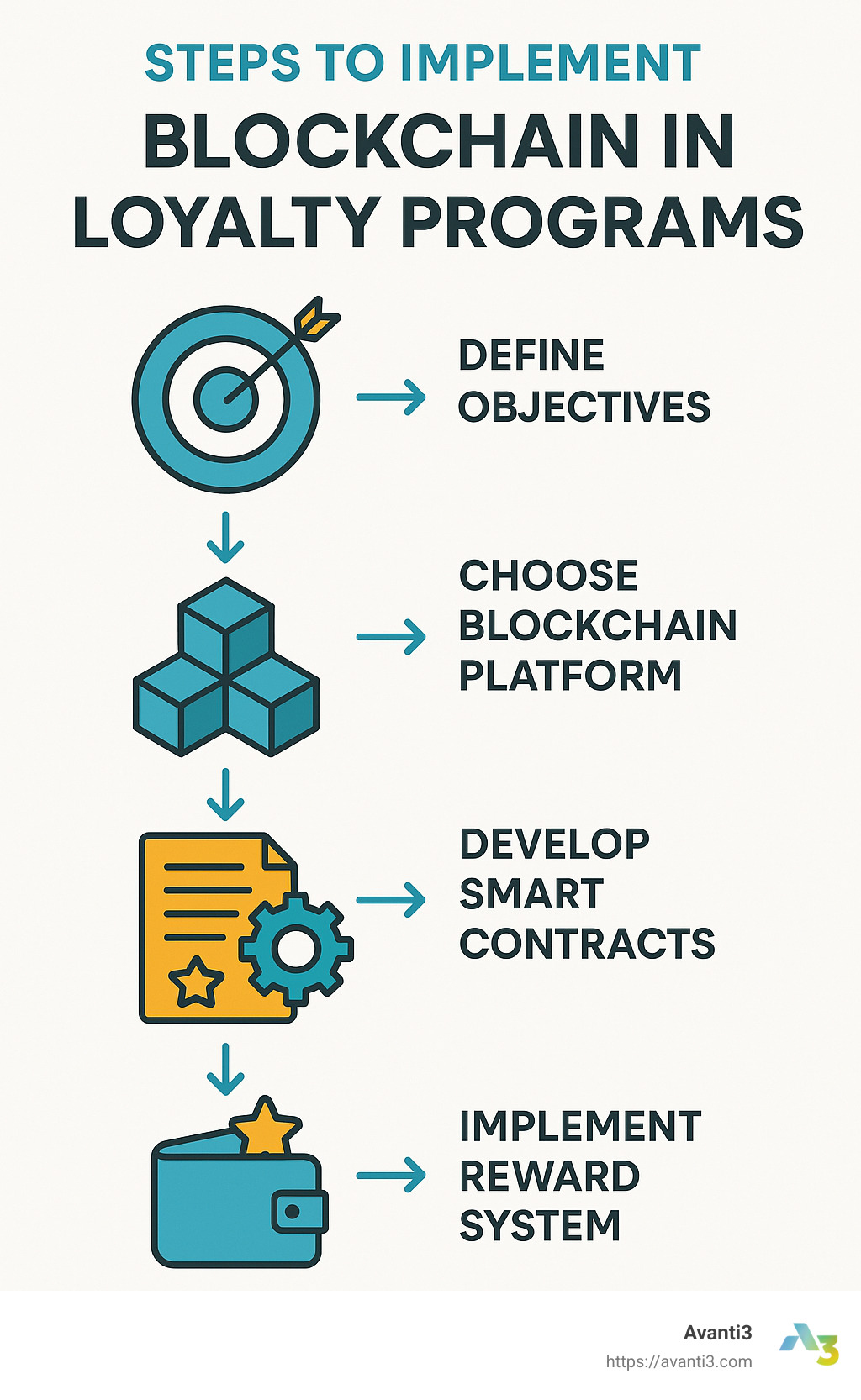
Overcoming Common Obstacles
Of course, integrating Blockchain-based rewards isn’t always without challenges—but they’re nothing you can’t handle with the right strategies.
One common challenge is technical compatibility with legacy systems. Older loyalty programs often run on platforms that aren’t immediately blockchain-friendly. Thankfully, you don’t have to abandon these valuable legacy systems overnight. Middleware solutions and APIs can create a bridge between your existing technology and a new blockchain layer, allowing both to work seamlessly together. You might also use hybrid approaches, maintaining core legacy platforms while gradually adding blockchain into customer-facing processes.
Another potential hurdle is customer adoption. Let’s face it—most customers don’t care about blockchain jargon. Instead, they care about rewards being simple, fast, and valuable. Focus on clear, straightforward communication highlighting practical advantages like instant gratification, easier redemption options, and more personalized rewards. Provide easy-to-use interfaces that hide the blockchain complexity behind the scenes. You can even offer small incentives for early adopters to encourage acceptance and gather valuable feedback.
Regulatory compliance is also critical, especially as blockchain regulations evolve. It’s important to involve legal experts familiar with blockchain-specific issues early on. Designing robust Know-Your-Customer (KYC) procedures, transparent data policies, and privacy-focused system designs can help you confidently steer legal complexities and remain compliant.
Finally, data privacy is a key consideration. While blockchain is transparent by nature, it doesn’t mean customer privacy is sacrificed. You can maintain privacy by keeping sensitive personal details off-chain and using private or permissioned blockchains for confidential data. Technologies like zero-knowledge proofs can also improve privacy by verifying transactions without revealing unnecessary information.
At Avanti3, we’ve helped numerous businesses steer these challenges smoothly. By blending innovative blockchain technologies with practical business strategies, we create seamless integrations that turn loyalty programs into powerful, customer-focused experiences.
The Role of Smart Contracts and Automation
One of the most exciting aspects of blockchain-based rewards is the magic of smart contracts. Think of smart contracts as your super reliable, always-on-time assistant who handles all the details for your loyalty program automatically.
These smart contracts are simply pieces of code stored on the blockchain. They automatically enforce the rules of your rewards program without needing anyone to manually verify or approve transactions. The beauty here is they work tirelessly (and error-free!) in the background, freeing up your team to focus on more creative, customer-focused tasks.
Because smart contracts clearly spell out the rules and trigger actions automatically, customers instantly receive their rewards as soon as they complete the necessary actions. Imagine a scenario where a customer books a hotel stay through your loyalty program. With a traditional rewards system, they’d wait days or weeks to see their points credit. But with smart contracts, their blockchain-based rewards appear in near-real-time—right when they check out. This instant gratification creates a stronger, more satisfying connection between customers and your brand.
Streamlining Reward Transactions with Blockchain-Based Rewards
Smart contracts don’t just speed up reward issuance; they also dramatically simplify loyalty program management. By automating reward calculations, validations, and distributions, businesses see enormous efficiency gains. Research shows smart contracts can cut operational costs by 25-30%, reducing administrative overhead and freeing resources for innovation and deeper customer engagement.
Let’s look at an example. Suppose you’re managing various promotional offers—time-limited deals, special bonuses for specific actions, or tiered rewards based on customer membership levels. Traditionally, each of these promotions would take hours of manual tracking and verifying. With smart contracts, these complexities become simple. The contract automatically tracks customer actions, applies the correct reward tier, and issues the rewards—all instantly and accurately.
This same efficiency applies to cross-partner incentives, where customers earn rewards across multiple brands or services. Smart contracts seamlessly handle the complexity behind the scenes, helping you build richer, more engaging partnerships without additional manual effort. Your customers get an effortless experience, and your team gets time back in their day.
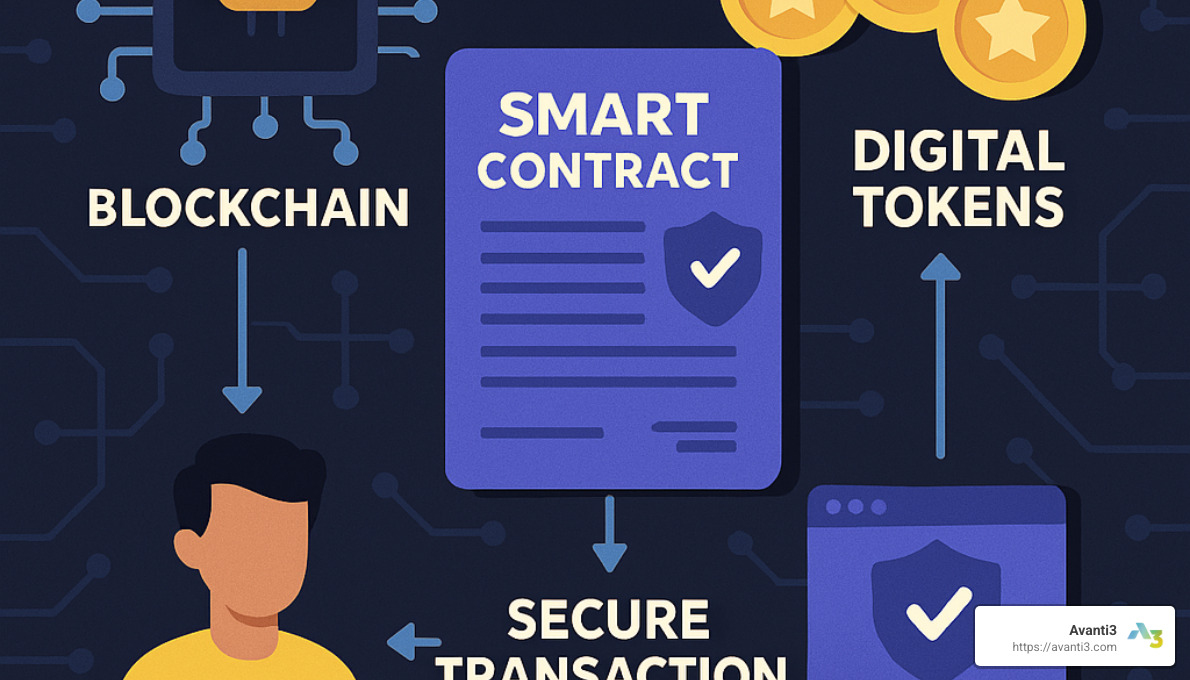
One loyalty program manager shared an inspiring change: “We used to spend nearly 15 hours every week manually tracking special promotions. With blockchain-based smart contracts, that’s dropped to zero. The system handles everything perfectly, and our customers receive rewards instantly. It’s honestly changed our whole workflow!”
At Avanti3, we take pride in designing smart contracts that are powerful yet user-friendly. We aim for sophisticated automation that simplifies your team’s life—creating loyalty programs that practically run themselves.
Facilitating Partnerships and Interoperability with Blockchain
One of the most exciting benefits of blockchain-based rewards is how easily they can bring brands together. Traditional loyalty programs tend to operate in isolation—each company managing its own points, rewards, and redemption rules. Partnering up is usually expensive and complicated, requiring custom integrations that can take months or even years.
Blockchain flips that script by creating open loyalty ecosystems. Brands of all shapes and sizes can effortlessly team up, share value, and offer combined rewards. The result? Happier customers who enjoy more meaningful rewards—and happier businesses who reach new audiences without breaking the bank.
Expanding Loyalty Networks through Blockchain-Based Rewards
Blockchain makes collaboration across different companies simple, secure, and transparent. For example, imagine a travel rewards ecosystem where points earned from a hotel stay could be effortlessly redeemed for flights, car rentals, dining, or entertainment experiences. Customers instantly see more value in every reward because their points can go further. Meanwhile, each brand gets exposure to a larger, shared customer base—without spending large amounts on advertising or complex integrations.
This kind of interconnected loyalty experience is exactly what today’s customers crave. In fact, research shows loyalty programs with healthy partner networks enjoy nearly double the engagement and retention rates compared to isolated programs.
Blockchain achieves this seamless integration in a few powerful ways. First, it enables cross-industry collaborations, allowing brands from entirely different sectors—like retail, travel, gaming, and finance—to unite their programs with ease. Because blockchain-based tokens are standardized and transparent, brands can quickly agree on rules, redemption values, and methods of exchange—no more lengthy negotiations or technical nightmares.
Secondly, blockchain supports seamless reward redemption across partners. Customers no longer have to jump through hoops to convert their rewards from one loyalty program to another. Instead, they can instantly redeem or transfer tokens across the entire network. This freedom and flexibility dramatically increase the perceived value of rewards, turning casual customers into passionate brand advocates.
Let’s not forget, blockchain also makes life easier behind the scenes. It reduces integration complexity by providing a unified, trusted protocol for exchanging rewards and data. Brands no longer need expensive new infrastructure or long IT projects to start collaborating. Instead, they can quickly join an existing blockchain network or easily set one up themselves.
Plus, with proper privacy controls, blockchain-based systems help brands gain valuable data insights. Companies can securely learn more about customer preferences, shopping habits, and interests across the entire ecosystem. This shared insight allows for more personalized experiences and smarter marketing strategies—benefiting both brands and consumers.
Real-world examples abound. Just recently, a global payments provider introduced a blockchain-powered rewards program, letting customers earn cryptocurrency rewards whenever they shop with partner brands. Within this ecosystem, rewards earned at one retailer can easily be spent at another, giving customers unprecedented choice and flexibility. It’s a win-win for everyone involved.
As Rahul Jaiswal, Principal Research Director, Retail, puts it:
“A Web3 blockchain-based NFT loyalty program increases the extent of partnerships and visibility for establishing a unique open loyalty ecosystem that drives advanced levels of customer retention and acquisition.”
At Avanti3, we see this potential every day. Our team specializes in building these interconnected loyalty networks, helping brands integrate blockchain smoothly into their existing reward systems. We handle all the technical details and design smart, scalable solutions that empower businesses to delight their customers and open up new growth opportunities.
Interested in learning more? Check out our Web3 Platform Solutions to find how your brand can join the blockchain-based rewards revolution.
Addressing Environmental Concerns of Blockchain
As exciting and empowering as blockchain-based rewards can be, some people still worry about the environmental impact of blockchain technology. I get it—no one wants to support a rewards program that’s secretly warming up the planet faster than your uncle’s old diesel truck.
But here’s the good news: not all blockchain networks are created equal. While early blockchain systems like Bitcoin did rely on energy-intensive methods (known as Proof-of-Work), today’s newer blockchain technologies have made huge strides towards sustainability.
Green Blockchain Technologies
Blockchain has come a long way—and it’s become much kinder to the environment in the process.
One significant advancement is the shift from energy-hungry Proof-of-Work algorithms to more efficient Proof-of-Stake (PoS) mechanisms. In simple terms, PoS doesn’t require warehouses full of powerful computers running endlessly to validate transactions. Instead, validators stake some cryptocurrency as collateral, dramatically cutting down on the energy needed.
Ethereum—the second-largest blockchain and a popular choice for loyalty programs—recently made headlines with its shift to PoS in what’s famously called “The Merge.” Completed in September 2022, this change slashed Ethereum’s energy use by an incredible 99.95%. That’s like going from a jumbo jet to an electric scooter overnight.
Other blockchain platforms have sustainability baked right into their design. Networks such as Solana, Polygon, and Algorand deliver high performance without guzzling energy. They’re ideal candidates for eco-friendly blockchain-based reward systems.
In fact, Ethereum’s new PoS model consumes only about 0.0026 TWh per year—just a tiny fraction of traditional financial systems or even typical data centers. Not bad for technology once criticized for being energy-intensive!

Many blockchain projects are also proactively embracing sustainability initiatives. They’re partnering with renewable energy providers, offsetting their carbon footprint through carbon credits, and constantly innovating to shrink their environmental impact even further.
When businesses implement blockchain-based rewards, a little planning goes a long way toward minimizing their environmental impact:
- Choose energy-efficient blockchain platforms, like those using Proof-of-Stake consensus methods.
- Optimize smart contract designs to keep computational requirements low, saving electricity and resources.
- Use Layer-2 solutions that process transactions off the main blockchain, further reducing energy demands.
- Work with sustainable blockchain providers who prioritize environmental responsibility and transparency.
At Avanti3, sustainability is a big deal for us. We carefully select the most energy-efficient blockchain technology and thoughtfully design our systems to minimize their environmental footprint. After all, blockchain-based rewards should make a positive impact—not just for your customers, but for the planet too.
By choosing these eco-conscious approaches, your business can confidently adopt blockchain-based solutions and show customers you’re serious about protecting our planet.
Scientific research on sustainable blockchain
Future Trends and Opportunities in Blockchain-Based Loyalty Programs
The landscape of blockchain-based rewards is constantly evolving, bringing exciting new possibilities for brands who want to stay ahead of the curve. As consumer tastes change and technological innovations emerge, loyalty programs need to adapt or risk becoming obsolete (think MySpace loyalty points—not a thing, but you get the picture).
The market for NFTs alone is set to experience impressive growth, expected to increase by roughly $113.9 billion between 2022 and 2027, at an annual rate of about 35%. Likewise, the broader loyalty management market is forecasted to surpass $24 billion by 2029, expanding at a healthy annual rate of around 23.5%. Clearly, the future is bright—and increasingly digital—for loyalty programs.
Embracing Emerging Technologies
Looking ahead, we see some fascinating ways blockchain will intersect with other exciting technologies like artificial intelligence (AI) and the Internet of Things (IoT). Imagine smart devices automatically rewarding customers when they complete certain actions—like your fridge giving you tokens for choosing a healthy snack. Or picture AI analyzing customer habits to deliver personalized rewards at exactly the right moment. (Because who doesn’t want a timely coffee discount when running low on caffeine?)
Advanced analytics will also play a critical role in shaping the future of loyalty programs. Thanks to blockchain’s transparent and secure record-keeping, businesses will have access to better information about customer behavior. This data goldmine allows brands to fine-tune their programs, predict trends, and measure their success more effectively.
Another major trend is hyper-personalization. Younger consumers are demanding more custom experiences. In fact, a whopping 96% of millennials think loyalty programs need a major refresh, and 41% of Gen Z customers say they aren’t satisfied with current offerings. Interestingly, 23% of millennials even say collecting NFTs is a hobby or investment. Clearly, there’s a strong appetite among younger generations for innovative digital solutions. Blockchain-based personalized rewards and collectibles (hello NFTs!) are perfectly positioned to meet this demand and boost customer satisfaction.
To see how this works in the real world, check out our Digital Reward System for Students. It’s a great example of how blockchain rewards can create personalized engagement for younger audiences.
The Road Ahead for Blockchain-Based Rewards
So, what’s next on the horizon for blockchain rewards programs? For starters, adoption rates are picking up speed. Industry experts predict that by 2025, more than a quarter of major loyalty programs will integrate some type of blockchain technology. This isn’t just a small adjustment—it’s a big shift in how brands think about loyalty.
Blockchain also has the potential to shake things up significantly. Many traditional loyalty programs rely on “breakage”—meaning they count on customers not redeeming their points. Blockchain flips that concept upside-down. Instead of hoping customers don’t use their rewards, businesses can create sustainable models that thrive on active customer engagement.
Based on current trends, here’s how we see blockchain loyalty programs evolving over the next few years:
- Several major blockchain-powered loyalty networks will emerge, anchored by influential players in industries like travel, retail, and finance.
- Tokenization will become more widespread, allowing rewards to be flexible and easily exchanged between different brands and platforms.
- Gamification will also become more common, as brands seek fun ways to boost customer engagement and create emotional connections.
- Partner ecosystems will expand significantly, breaking down industry barriers and letting customers redeem rewards wherever they find most valuable.
For brands, the key takeaway is clear: blockchain-based rewards aren’t just a nifty add-on—they represent a whole new way of engaging with customers. Businesses that accept blockchain early can set themselves apart clearly from competitors. (And who doesn’t like being ahead of the game?)
At Avanti3, we’re excited to help brands steer this evolving landscape. Our expertise in Web3 technologies—including blockchain, NFTs, and AI—enables us to create cutting-edge, personalized loyalty solutions that deliver real value to brands and their customers.
Frequently Asked Questions about Blockchain-Based Rewards
How does blockchain improve security in loyalty programs?
One of the biggest headaches for businesses running traditional loyalty programs is security. Fraud is a major issue, often reaching up to 70% in some programs. That’s where blockchain-based rewards really shine.
Blockchain technology uses advanced cryptographic security—think of it as digital armor that stops hackers in their tracks. Every transaction recorded on the blockchain is encrypted, making unauthorized changes practically impossible.
Another great feature is its immutable transaction records. Once entered, data can’t be altered or deleted. This creates a permanent, tamper-proof record of all rewards earned, transferred, or redeemed, reducing the likelihood of fraud dramatically.
Additionally, blockchain transactions don’t rely on one central authority. Instead, they use distributed verification where multiple network nodes independently validate each transaction. This means there’s no single point of weakness for fraudsters to exploit.
Finally, blockchain provides a completely transparent audit trail. Both companies and customers can easily view and verify transaction histories. Suspicious activity quickly stands out, allowing businesses to respond immediately and keep customers confident and happy.
What are the cost implications of implementing blockchain-based rewards?
Implementing blockchain-based rewards does involve some initial investments—but the savings and benefits usually outweigh those initial costs.
At the start, businesses face expenses related to technical development, staff training, integrating blockchain with existing systems, and customer onboarding. There may also be some necessary updates to existing loyalty programs to make them blockchain-ready.
Ongoing costs include blockchain transaction fees (these vary depending on the platform), maintaining the system, and providing customer support.
However—and this is a big “however”—the long-term cost savings can be huge. Blockchain significantly reduces fraud-related losses (as mentioned, sometimes up to 70%), and the automation provided by smart contracts dramatically lowers administrative overhead.
Plus, blockchain streamlines partner integrations. With traditional loyalty programs, merchants spend around $35 billion per year on third-party credit card servicing linked to reward points. Blockchain’s efficiency can substantially cut these expenses, freeing up money to reinvest in your customers.
Taking a phased approach to implementation is a smart way to manage initial costs and still quickly gain the benefits. At Avanti3, we help clients map out a plan that delivers clear value without breaking the bank.
How can customers benefit from tokenized rewards?
Customers are often confused and frustrated by traditional reward programs. Frequent flyer points or credit card rewards can be complicated and limiting—54% of Americans say airline rewards are confusing, and 45% feel the same about credit card loyalty programs. Blockchain-based rewards offer a much-needed solution through tokenization.
Tokenized rewards provide greater flexibility, letting customers use their rewards across multiple brands and platforms. Imagine earning points at your favorite coffee shop then using them at your preferred bookstore, or even exchanging them with friends. This cross-platform use adds significant value compared to traditional points stuck in one place.
And speaking of value, traditional points often depreciate or expire. Tokenized rewards, especially NFTs or convertible tokens, can hold steady or even increase in value—making your loyalty feel truly rewarding.
Another perk customers love is real-time transactions. No more waiting days or weeks—tokenized rewards appear instantly in their accounts, ready to use right away. This speedy gratification makes reward programs much more satisfying and engaging.
Transparency is another bonus. Customers can clearly see their rewards balance, transaction history, and redemption options at any time, building trust and eliminating confusion.
Tokenized rewards also give customers real ownership. Unlike traditional points, customers can transfer, trade, or even sell these tokens according to the rules of the program. Customers truly feel in control of what they’ve earned.
Finally, tokenization simplifies the customer experience. Instead of juggling countless complicated loyalty programs, customers can enjoy a streamlined, easy-to-use system that consolidates their rewards in one convenient digital wallet.
Conclusion
As we’ve explored together, blockchain-based rewards are changing the way brands approach customer loyalty—and for good reason. They tackle many of the pain points found in traditional loyalty programs, like fragmented experiences, confusing rules, security risks, and limited redemption options. By leveraging blockchain technology, businesses can create loyalty experiences that are not just more effective, but also more enjoyable.
The numbers reveal how significant this shift really is. The loyalty management market is on track to surpass $24 billion by 2029, signaling a clear move toward more meaningful, transparent, and secure relationships between customers and brands. Much of this impressive growth comes from the distinct benefits that blockchain provides to both businesses and consumers alike.
For businesses, adopting blockchain-based rewards means enjoying improved security, streamlined operations, significant cost savings, and easier collaboration with partners. On the customer side, blockchain rewards offer greater flexibility, immediate reward crediting, clearer transparency, and significantly increased value. Everybody wins—and that’s exactly what good loyalty programs should do!
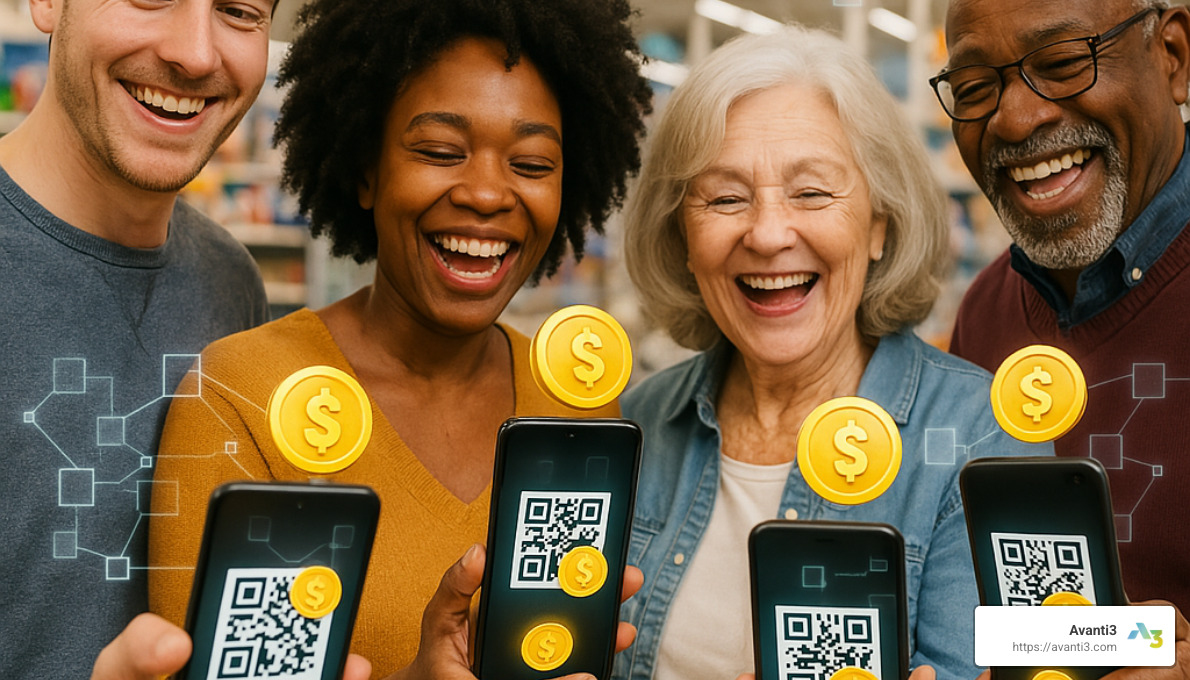
At Avanti3, we’re proud to be at the forefront of this exciting shift. Our team specializes in integrating innovative Web3 technologies—such as blockchain, NFTs, AR/VR, and AI—to create customized digital engagement tools and fintech solutions. In other words, we help brands turn customer loyalty into unforgettable experiences (and yes, we have fun doing it!).
Whether you’re looking to upgrade your existing loyalty program or build a brand-new system from scratch, we’re here to guide you every step of the way. From assessing your current systems, to designing seamless blockchain integrations, all the way through to launch and beyond—we’ve got you covered.
The future of customer loyalty is here, and it’s tokenized, transparent, and transformative. The brands that accept blockchain-based rewards early will position themselves ahead of the competition, forging stronger, more meaningful connections with their customers.
Ready to explore how blockchain-based rewards can lift your customer engagement strategy? Get in touch with our friendly team at Avanti3. We’ll listen carefully to your goals, answer any questions you have, and help you open up the full potential of blockchain-based loyalty.
Learn more about our Digital Reward System and explore exciting opportunities with Augmented Reality NFTs.

